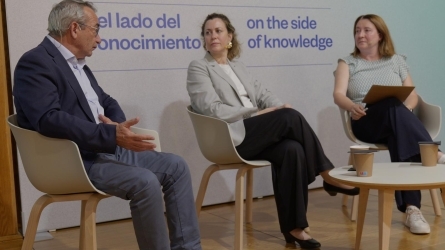Effects of environmental exposures on human health

Environmental pollution, responsible for 25% of the diseases we suffer, is a problem that is and will be if serious action is not taken on climate change. "We have improved in water quality or waste management, but the planet is not exactly managed in a sustainable way. It makes no sense if we eat fish from the Pacific or wear pants made in China. These are ways of consuming that generate environmental alterations that have a direct impact on health". This was stated by the director of the course "Tell me where you live and I will tell you what you are exposed to. The health effects of environmental factors" and researcher at the BIODONOSTIA Institute Jesús Ibarluzea.
Our perception of environmental risk is low. Only when something happens, as has happened with the COVID, does it become front page news. "In Euskadi we live in acceptable levels in all forms of environmental pollution, but going into details there are exceptions derived, for example, from the lack of flat land." Because of the orography we live in population centers where everything is concentrated, industry, carts, pollution and the products we use in our daily life at home: clothes, fragrances, paints or cleaning products. In short, thousands of chemical substances to which we are exposed and whose knowledge is sometimes partial.
Water quality has improved a lot in the Basque Country, as has environmental pollution - thanks to the gradual disappearance of the steel industry, but we have a long way to go. Do current levels still have an effect?
Air pollution has dropped considerably in recent years. Studies have shown its incidence in asthmatic diseases or thyroid conditions from old exposures.
But do new environmental exposures to new products generate risks? Jesús Ibarluzea gave as an example the use of "bisphenol A", frequently used in construction materials, plastics or resins, but also in oral treatments or the coating of food cans, which the industry has quickly replaced with Bisphenol E or whatever is needed before the administration reacts. On the other side, he mentioned pesticides, which have been demonized but have also made food possible for billions in the world.
The sources of exposure to pollutants in a house start with the water we drink and use for washing or cooking; the air that circulates depending on whether it has balconies or windows to the outside, the paints and materials used in construction to the pens we use. The other possible routes of contamination are food (classic or new contaminants) and hygiene creams, beauty or personal care products. "This is where endocrine disruptors can be found, which affect all secondary sexual development in adolescence (sexual differentiation) and reproductive capacity (sperm quality).
Benzophenone or phthalates present in hygiene products, sunscreens and in many plastic materials can function as hormones that, added to the enormous variety of products with which we are in contact, accumulate at the biological level inside the body. The cumulative effects of exposure to multiple substances should also be taken into account.
The levels of mercury found among children at birth are higher due to the consumption of fish in the Basque Country, but it does not affect their cognitive system until they are 4 years old. Jesus Ibarluzea and his team do recommend a reduction in the intake of large oily fish during pregnancy and early childhood. There is no problem with the anchovies, horse mackerel or bonito that we consume.
"We are very afraid of high-voltage power lines and electromagnetic fields, but not of the use of telephones and screens, especially among children. The antenna scares us, but we still give the tablet to a child when the risk is much greater. What is a one-year-old child doing with a mobile phone in his hand?
We perceive long exposures to screens from the point of view of a beneficial effect and therefore eliminate the perception of the risk they may entail.
What we have realized, especially in this pandemic, is that living in a green environment means more well-being and health. Living in a house with a terrace, balcony or outdoor window is totally different. To feel the sun, the cold or the heat. Living in green or blue sea areas favor our health because among other things reduce other exposures that can be toxic. It is known that, during confinement, anxiety-related symptomatology clearly decreased in these environments.




